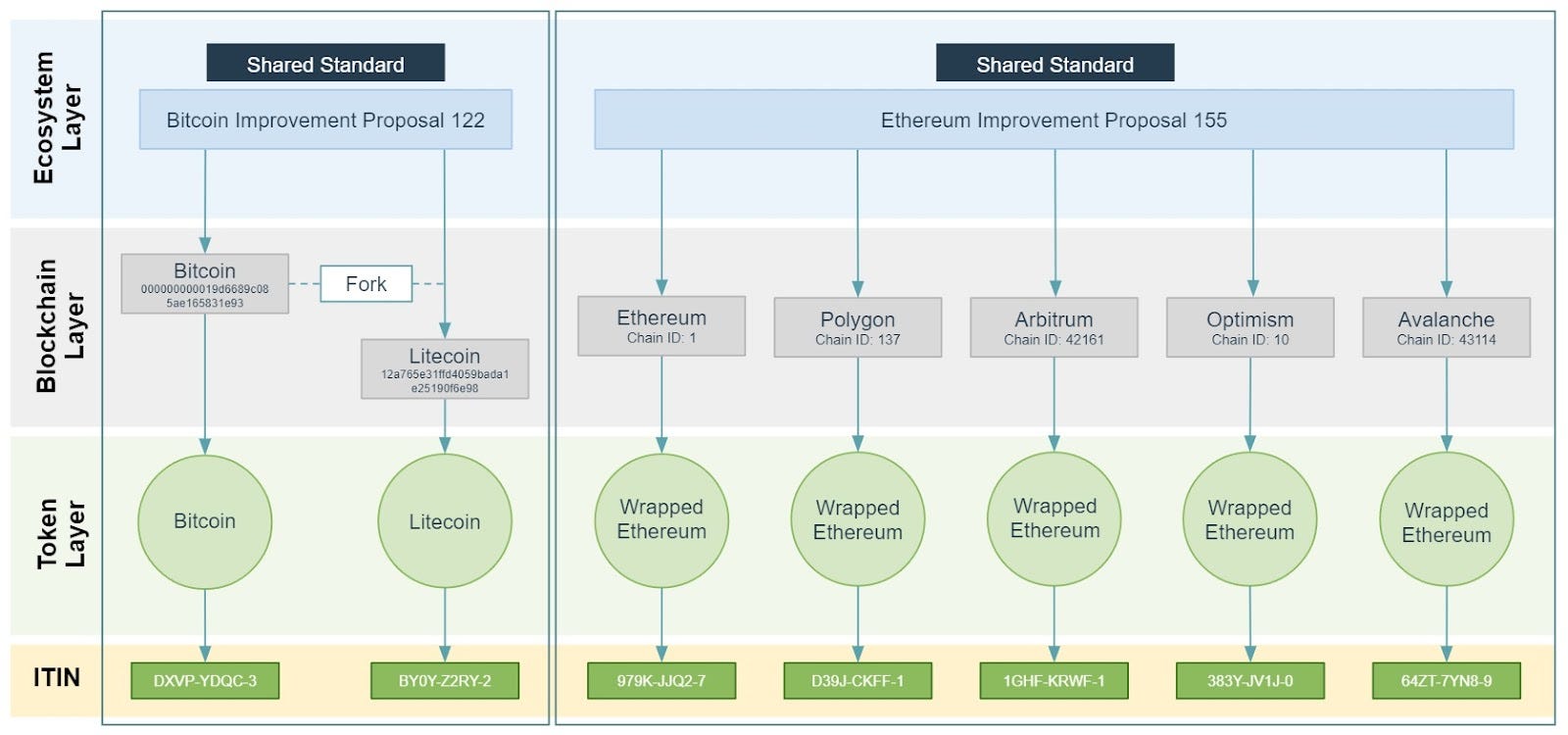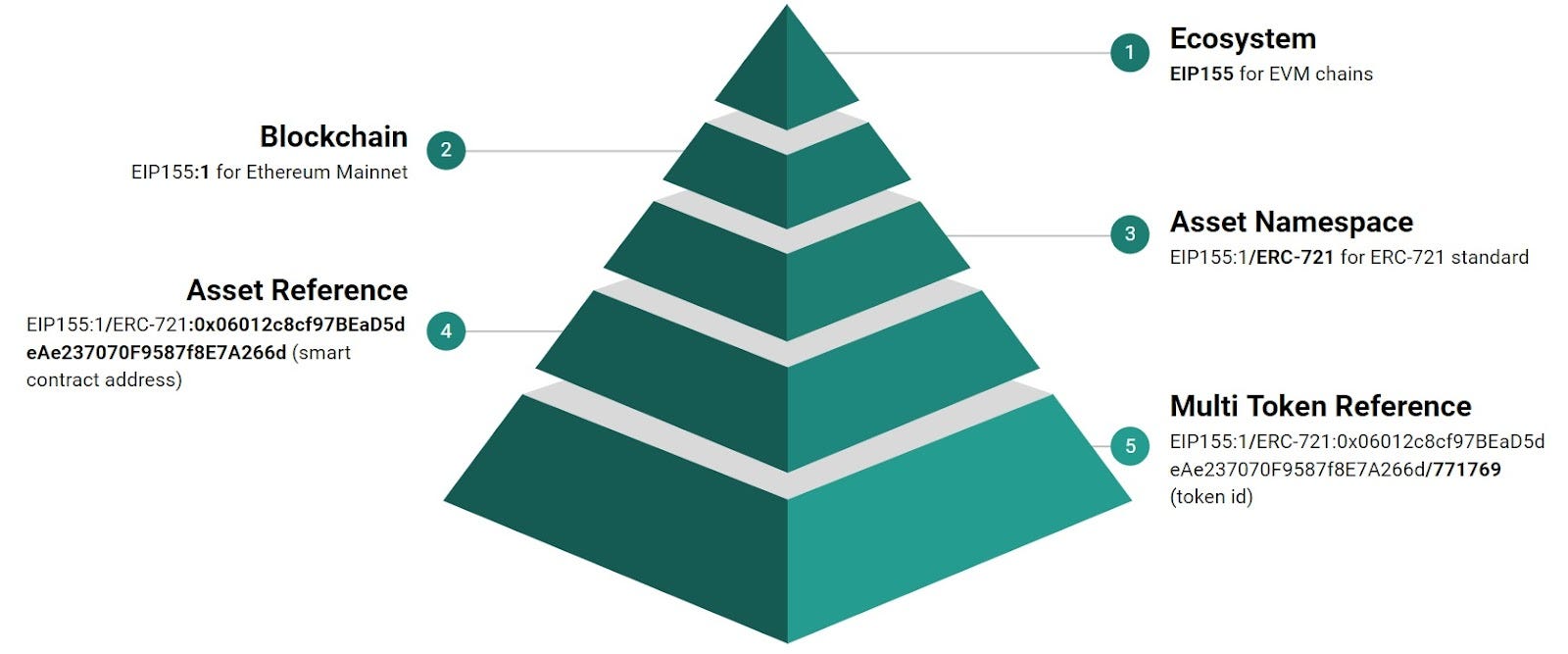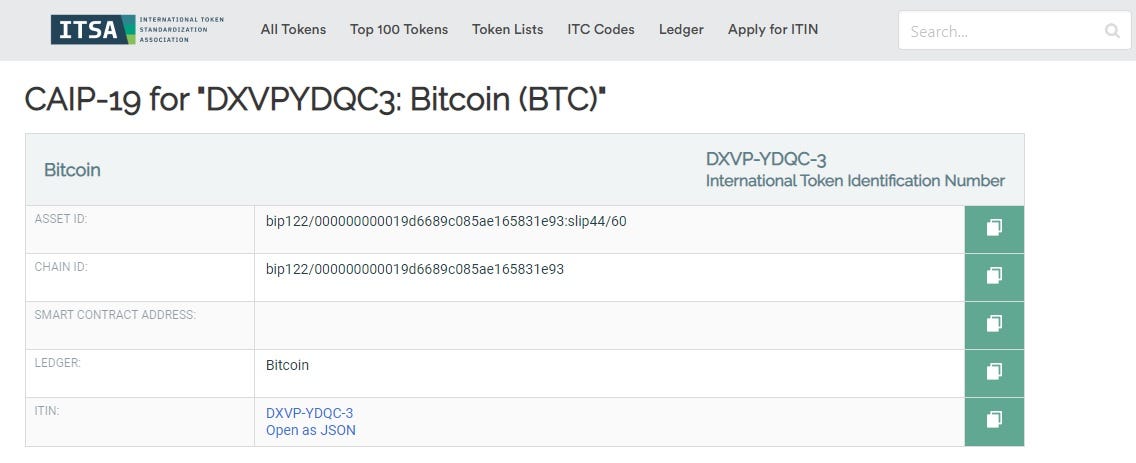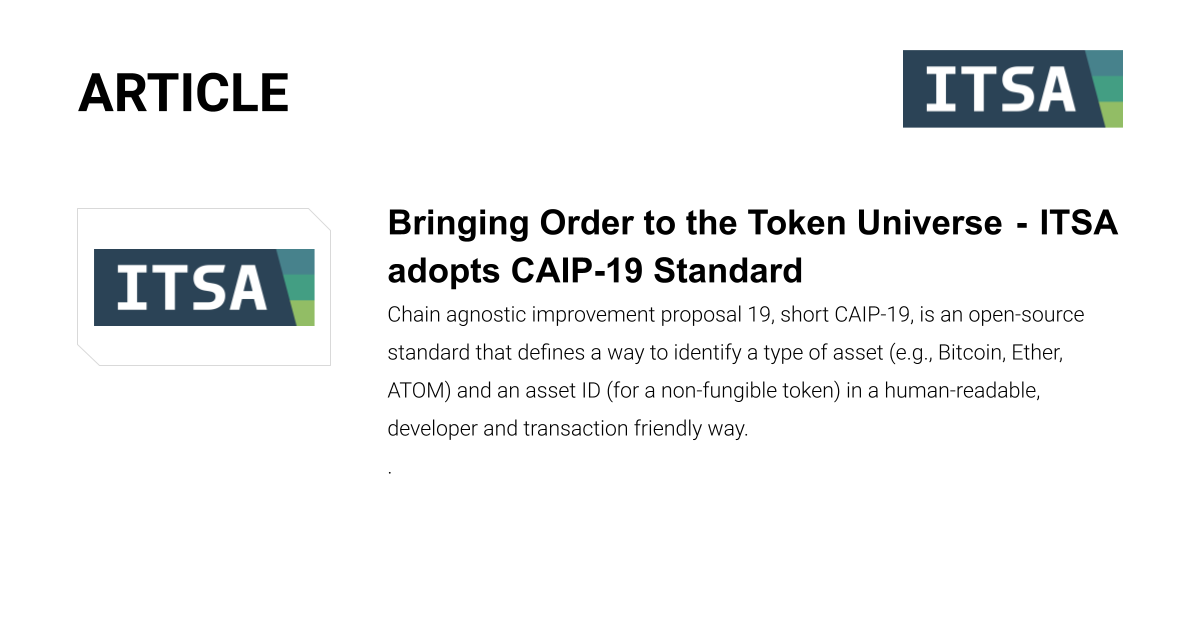Share this
Bringing Order to the Token Universe — ITSA adopts CAIP-19 Standard
by Christian Viehof on Oct 25, 2022 7:15:00 AM
Identifiers such as the International Security Identification Number (ISIN) enable the secure trading of securities and simplify international data reconciliation. With the International Token Identification Number (ITIN), ITSA has created a market standard that enables the same for tokens, be it a native crypto asset, an NFT or an ERC-20 token. The ITIN is thus an all-purpose tool to efficiently reference the expanding token universe.
Authors: Christian Viehof, Valentin Kalinov
How to distinguish forks
Bitcoin and Ethereum are the two most popular cryptocurrencies out there. Success always attracts imitators, so it’s no surprise that some of their biggest competitors are forks based on almost identical source code, such as Litecoin or the Binance Smart Chain. The fact that the code of Ethereum and that of the Binance Smart Chain are very similar increases compatibility, but at the same time, also the probability of making a mistake since the structure and terminology are very similar.
Let’s take Bitcoin and Litecoin as an example to get a better understanding. Both blockchains have almost identical protocols since Litecoin is a Bitcoin fork. Despite the similarities, there are also clear differences by which the blockchains can be precisely differentiated, one of which is the hashes of their blocks. The genesis hash of the Bitcoin blockchain, i.e. the first block of the blockchain, is “000000000019d6689c085ae165831e93” and the one for Litecoin is “12a765e31ffd4059bada1e25190f6e98”. The use of the different hashes to distinguish Bitcoin and its forks was decided in the Bitcoin Improvement Proposal 122 (BIP122). Thus, BIP122 acts as a common denominator for Bitcoin and all of its forks.
Unfortunately, this logic only applies to Bitcoin, so it requires a different methodology for Ethereum. In 2016, Vitalik Buterin published the Ethereum Improvement Proposal 155 (EIP155), which was intended to prevent replay attacks that happen when a malicious actor intercepts and then repeats a valid data transmission that goes through a network. With EIP155, a chain ID was introduced, which simplifies the differentiation of Ethereum Virtual Machine (EVM) compatible blockchains such as Ethereum, Optimism, Polygon or Avalanche. So with Ethereum, the block hash is not used for identification.

Tokenbase adopts CAIP-19 standard
Chain agnostic improvement proposal 19, short CAIP-19, is an open-source standard that defines a way to identify a type of asset (e.g., Bitcoin, Ether, ATOM) and an asset ID (for a non-fungible token) in a human-readable, developer and transaction friendly way. Currently, each wallet or exchange needs to create its own registry of types of assets and their associated metadata, for example, Trust-Wallet or CoinMarketCap. By providing a unique asset type and an asset ID, developers can reduce the risk of confusion between different assets. For better understanding, we have prepared an example that illustrates the identification of a CryptoKitties NFT.
- For the exact identification of the NFT, we must first define its ecosystem. In this case, we know that the KryptoKitties NFTs are located on the Ethereum blockchain. Therefore, the identification starts with EIP155 as the common denominator for all EVM-compatible blockchains.
- In the next step, we need to find the matching ChainID and link it to the ecosystem. For the Ethereum mainnet, the ChainID is 1, so we get EIP155:1.
- Now we have to select the token standard. For fungible tokens, it is usually the ERC-20 standard; for non-fungible tokens, the ERC-721 standard. Since the KryptoKitties are NFTs, the CAIP standard needs to be extended by ERC-721, so we obtain EIP155:1/ERC-721.
- Afterwards, the NFTs’ smart contract address must be appended, which gives us EIP155:1/ERC-721:0x06012c8cf97BEaD5deAe237070F9587f8E7A266d.
- Lastly, we need to add the token ID since the CryptoKitties NFTs are a multi-token contract. So there is one smart contract address for over 2 million CryptoKitties NFTs. If we add the token ID, we get EIP155:1/ERC-721:0x06012c8cf97BEaD5deAe237070F9587f8E7A266d/771769.

The CAIP standard has already been integrated into Tokenbase and is currently in its beta testing phase. By the end of the year, the CAIP standard will be fully integrated into the database without any interruptions to the API.

The International Token Standardization Association (ITSA) e.V.
The International Token Standardization Association (ITSA) e.V. is a not-for-profit association of German law that aims at promoting the development and implementation of comprehensive market standards for the identification, classification, and analysis of DLT- and blockchain-based cryptographic tokens. As an independent industry membership body, ITSA unites over 100 international associated founding members from various interest groups. In order to increase transparency and safety on global token markets, ITSA currently develops and implements the International Token Identification Number (ITIN) as a market standard for the identification of cryptographic tokens, the International Token Classification (ITC) as a standard framework for the classification of cryptographic tokens according to their inherent characteristics. ITSA then adds the identified and classified token to the world’s largest register for tokens in our Tokenbase.
- The International Token Identification Number (ITIN) is a 9-digit alphanumeric technical identifier for both fungible and non-fungible DLT-based tokens. Thanks to its underlying Uniform Token Locator (UTL), ITIN presents a unique and fork-resilient identification of tokens. The ITIN also allows for the connecting and matching of other media and data to the token, such as legal contracts or price data, and increases safety and operational transparency when handling these tokens.
- The International Token Classification (ITC) is a multi-dimensional, expandable framework for the classification of tokens. Current dimensions include technological, economic, legal, and regulatory dimensions with multiple sub-dimensions. By mid-2021, there will be at least two new dimensions added, including a tax dimension. So far, our classification framework has been applied to 99% of the token market according to market capitalization of classified tokens.
- ITSA’s Tokenbase currently holds data on over 4000 tokens. Tokenbase is a holistic database for the analysis of tokens and combines our identification and classification data with market and blockchain data from external providers. Third-party data of several partners is already integrated, and API access is also in development.
Remarks
If you like this article, we would be happy if you forward it to your colleagues or share it on social networks. More information about the International Token Standardization Association can be found on the Internet, on Twitter, or on LinkedIn.
Christian Viehof is an Executive Director at the International Token Standardization Association (ITSA) e.V., working to create the world’s largest token database including a classification framework and unique token identifiers and locators. He completed his Bachelor in Economics at the University of Bonn, the Hong Kong University and the London School of Economics and Political Science with a focus on Behavioral Economics and Finance. Currently pursuing his Master of Finance at the Frankfurt School of Finance and Management, you can contact him via christian.viehof@itsa.global and connect with him on Linkedin, if you would like to further discuss ITSA e.V. or have any open questions.
Valentin Kalinov is an Executive Director at International Token Standardization Association (ITSA) e.V., working to create the world’s largest token database, including a classification framework and unique token identifiers and locators. He has over five years of experience working at BlockchainHub Berlin in content creation and token analysis, as a project manager at the Research Institute for Cryptoeconomics at the Vienna University of Economics and token analyst at Token Kitchen. You can contact Valentin via valentin.kalinov@itsa.global and connect on Linkedin if you would like to further discuss ITSA e.V. or have any other open questions.


